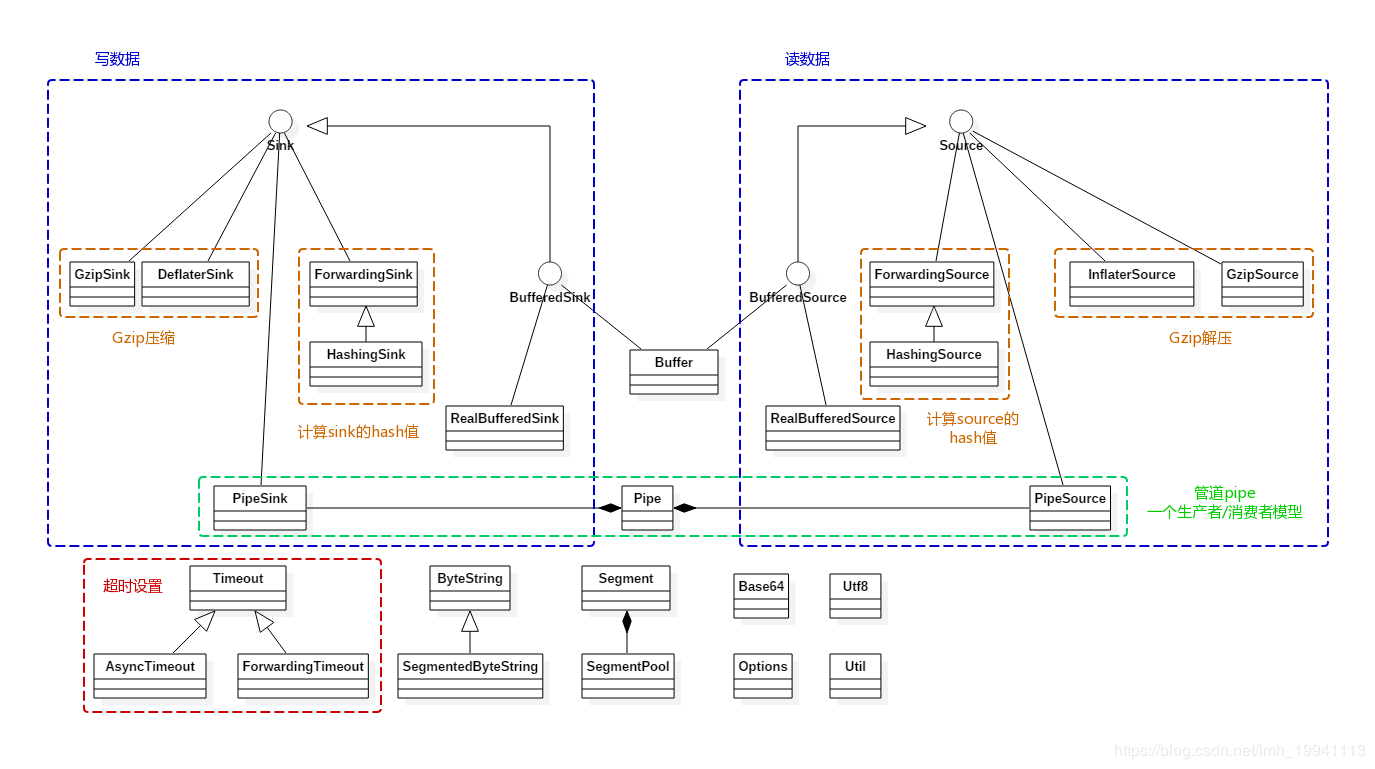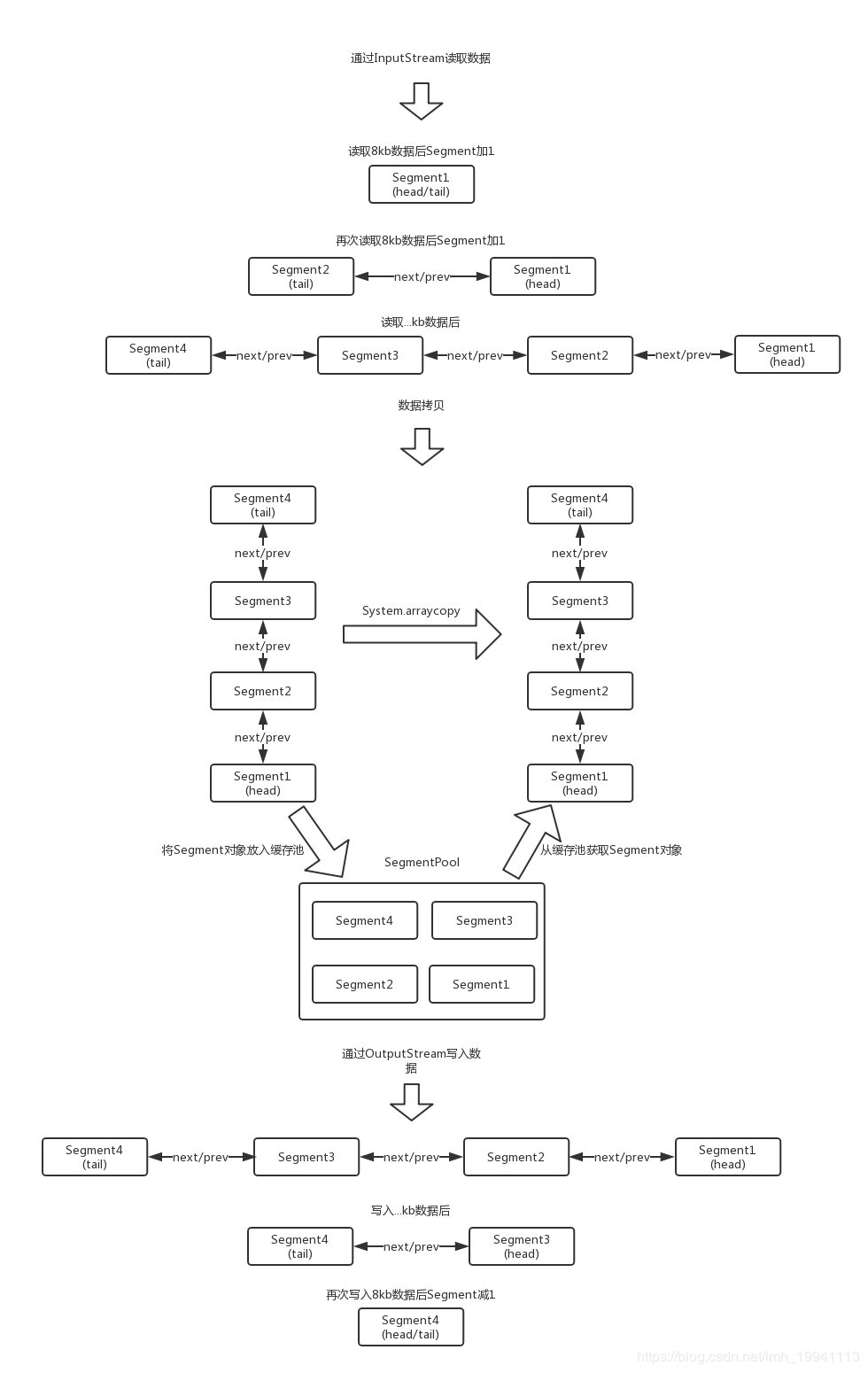okio是Square开源框架之一,它对java.io和java.nio做了补充,使访问,存储和数据处理变得更加容易。它最早是Okhttp组件之一。

1、ByteString与Buffer
Okio主要围绕ByteString与Buffer这两个类展开,其主要功能都封装在这两个类中:
ByteString:是一个类似String的不可变类,它可以很容易的在byte与String之间进行转换。该类提供了编/解码为hex,md5,base64及UTF-8等方法。Buffer:是一个可变的字节序列。 与ArrayList一样,无需提前调整缓冲区大小。Buffer内部维护了一个双向链表,从链表尾部写入数据,头部读取数据。
ByteString和Buffer做了一些节省CPU和内存的操作。 如果将一个字符串编码为ByteString,ByteString就会缓存对该字符串的引用(以空间换时间),这样如果以后对其进行编/解码等操作,则无需在byte与String之间进行转换。
//字符串对应的字节数据,避免再一次转换
final byte[] data;
//字符串
transient String utf8; // Lazily computed.
Buffer内部维护了一个以Segment为节点的双向链表。 当数据从一个Buffer移动到另一个Buffer时,仅需要进行一次数据拷贝,且它会重新分配Segment的所有权,而不是重新创建Segment对象。
2、Source与Sink
Okio包含自己的流类型,称为Source和Sink,其工作方式虽然类似InputStream和OutputStream,但它与Java I/O相比具有以下优势(参考自Android学习笔记——Okio):
Okio实现了I/O读写的超时机制(Timeout),防止读写出错从而导致一直阻塞。- N合一,
OKio精简了输入输出流的类个数 - 低的CPU和内存消耗,引入
Segment和SegmentPool复用机制 - 使用方便。
ByteString处理不变byte,Buffer处理可变byte。 - 提供了一系列的工具。
OKio支持md5、sha、base64等数据处理
Source、Sink可以与InputStream、OutputStream互相操作。我们可以将任何Source视为InputStream,也可以将任何InputStream视为Source。同样适用于Sink和InputStream。
3、Okio数据读写流程
前面简单介绍了Okio,下面就来看看如何使用。
//okio实现图片复制
public void copyImage(File sinkFile, File sourceFile) throws IOException {
//try里面的代码是Okio的标准写法,不能改变
try (Sink sink = Okio.sink(sinkFile);
BufferedSink bufferedSink = Okio.buffer(sink);
//从文件读取数据
Source source = Okio.source(sourceFile);
BufferedSource bufferedSource = Okio.buffer(source)) {
//图片复制
bufferedSink.write(bufferedSource.readByteArray());
//设置超时时间为1秒中,
sink.timeout().deadline(1, TimeUnit.SECONDS);
//写入数据,将字符串以UTF-8格式写入,Okio专门针对utf-8做了处理
bufferedSink.writeUtf8(entry.getKey())
.writeUtf8("=")
.writeUtf8(entry.getValue())
.writeUtf8("\n");
//读取数据
String str=bufferedSource.readUtf8();
//读取数据并返回一个ByteString
ByteStringstr=bufferedSource.readByteString();
}
}
正如前面所说的那样,Okio使用起来非常方便。由于Java字符串采用的是UTF-16编码,而一般开发中使用的都是UTF-8编码,所以Okio对字符串编码做了特殊处理。
3.1、Okio读数据原理分析
Source的意思是水源,它对应着输入流,在Okio中通过Okio.source方法来获得一个Source对象。
//在Okio这个类中关于source重载的方法还是蛮多的,这里以文件为例
public static Source source(File file) throws FileNotFoundException {
if (file == null) throw new IllegalArgumentException("file == null");
return source(new FileInputStream(file));
}
public static Source source(InputStream in) {
return source(in, new Timeout());
}
private static Source source(final InputStream in, final Timeout timeout) {
...
//这里才是真正读去数据的地方
return new Source() {
@Override public long read(Buffer sink, long byteCount) throws IOException {
...
try {
//每次写数据时都先检查是否超时,默认未设置超时
timeout.throwIfReached();
//获取链表的尾节点
Segment tail = sink.writableSegment(1);
//由于每个Segment的SIZE为8KB,所以每一次拷贝不能超过这个值
int maxToCopy = (int) Math.min(byteCount, Segment.SIZE - tail.limit);
//通过InputStream读取数据
int bytesRead = in.read(tail.data, tail.limit, maxToCopy);
//数据读取完毕
if (bytesRead == -1) return -1;
//可写取位置往后移
tail.limit += bytesRead;
//读取的总字节数
sink.size += bytesRead;
//返回当前读取的字节数
return bytesRead;
} catch (AssertionError e) {
...
}
}
...
};
}
可以发现,这个的Source是一个匿名对象。得到Source对象后,通过Okio.buffer方法将该对象传递给BufferedSource,BufferedSource是一个接口,它的具体实现类是RealBufferedSource。
在上面例子中是调用RealBufferedSource的readByteArray方法来读取数据,下面就来看这个方法的实现。
//RealBufferedSource对应的Buffer
public final Buffer buffer = new Buffer();
@Override public byte[] readByteArray() throws IOException {
//将数据写入buffer
buffer.writeAll(source);
//将所有数据已字节数组形式返回
return buffer.readByteArray();
}
在readByteArray方法中会首先将数据写入到Buffer中,并生成一个双向链表。
@Override public long writeAll(Source source) throws IOException {
if (source == null) throw new IllegalArgumentException("source == null");
long totalBytesRead = 0;
//这里的source就是前面在Okio中创建的匿名Source对象
for (long readCount; (readCount = source.read(this, Segment.SIZE)) != -1; ) {
totalBytesRead += readCount;
}
return totalBytesRead;
}
将数据写入Buffer后,调用Buffer的readByteArray方法生成一个字节数组并返回。
@Override
public byte[] readByteArray() {
try {
//在读取数据时,就会得到size的大小
return readByteArray(size);
} catch (EOFException e) {
throw new AssertionError(e);
}
}
@Override
public byte[] readByteArray(long byteCount) throws EOFException {
checkOffsetAndCount(size, 0, byteCount);
...
//创建一个大小为size的byte数组
byte[] result = new byte[(int) byteCount];
//将读取的数据写入这个数组中
readFully(result);
return result;
}
@Override
public void readFully(byte[] sink) throws EOFException {
int offset = 0;
while (offset < sink.length) {
//不断的将数据写入sink数组中
int read = read(sink, offset, sink.length - offset);
if (read == -1) throw new EOFException();
offset += read;
}
}
@Override
public int read(byte[] sink, int offset, int byteCount) {
checkOffsetAndCount(sink.length, offset, byteCount);
Segment s = head;
if (s == null) return -1;
int toCopy = Math.min(byteCount, s.limit - s.pos);
//进行数据拷贝
System.arraycopy(s.data, s.pos, sink, offset, toCopy);
s.pos += toCopy;
size -= toCopy;
//释放Segment并将其放入缓冲池
if (s.pos == s.limit) {
head = s.pop();
SegmentPool.recycle(s);
}
return toCopy;
}
这样就将数据写入到一个新的数组中,并将链表中的所有Segment重新初始化并放入池中。
3.2、Okio写数据原理分析
Sink的意思是水槽,它对应着输出流。通过Okio.sink来获取一个Sink对象。
public static Sink sink(File file) throws FileNotFoundException {
if (file == null) throw new IllegalArgumentException("file == null");
return sink(new FileOutputStream(file));
}
public static Sink sink(OutputStream out) {
return sink(out, new Timeout());
}
private static Sink sink(final OutputStream out, final Timeout timeout) {
...
//创建一个匿名Sink对象
return new Sink() {
@Override public void write(Buffer source, long byteCount) throws IOException {
checkOffsetAndCount(source.size, 0, byteCount);
//写入数据
while (byteCount > 0) {
//每次写数据时都先检查是否超时,默认未设置超时
timeout.throwIfReached();
//获取头结点
Segment head = source.head;
//能copy的最小字节
int toCopy = (int) Math.min(byteCount, head.limit - head.pos);
//通过OutputStream来写入数据
out.write(head.data, head.pos, toCopy);
//可读取的位置向后移动
head.pos += toCopy;
//减少可写入的字节数
byteCount -= toCopy;
//减少buffer中字节数
source.size -= toCopy;
//达到最大可写的位置
if (head.pos == head.limit) {
//释放节点
source.head = head.pop();
SegmentPool.recycle(head);
}
}
}
...
};
}
获得Sink对象后,将该对象传递给BufferedSink,BufferedSink是一个接口,它的具体实现是RealBufferedSink。
public static BufferedSink buffer(Sink sink) {
return new RealBufferedSink(sink);
}
在3.1节中讲了通过InputStream读取数据并返回一个字节数组。这里就将这个数组通过RealBufferedSink的write方法写入到新的文件中。
@Override public BufferedSink write(byte[] source) throws IOException {
if (closed) throw new IllegalStateException("closed");
buffer.write(source);
return emitCompleteSegments();
}
写入数据跟读取数据流程基本上一样,需要先将数据写入到Buffer中。
@Override
public Buffer write(byte[] source) {
if (source == null) throw new IllegalArgumentException("source == null");
return write(source, 0, source.length);
}
@Override
public Buffer write(byte[] source, int offset, int byteCount) {
...
int limit = offset + byteCount;
while (offset < limit) {
Segment tail = writableSegment(1);
int toCopy = Math.min(limit - offset, Segment.SIZE - tail.limit);
//进行数据拷贝
System.arraycopy(source, offset, tail.data, tail.limit, toCopy);
offset += toCopy;
tail.limit += toCopy;
}
size += byteCount;
return this;
}
前面说过Buffer维护的是一个链表,所以这里也是将数据写入一个链表中,由于在数据读取完毕后会将Segment对象重新初始化并放入到池中,所以这里就不用创建新的Segment对象,直接从池中获取即可。在写入Buffer成功后,再调用emitCompleteSegments方法,该方法就是将数据从Buffer写入到新文件。
@Override public BufferedSink emitCompleteSegments() throws IOException {
if (closed) throw new IllegalStateException("closed");
long byteCount = buffer.completeSegmentByteCount();
if (byteCount > 0) sink.write(buffer, byteCount);
return this;
}
这里的Sink就是在Okio中创建的匿名对象,在Sink对象中通过OutputStream将数据写入到新文件。
总体流程如下。

4、Segment及SegmentPool
Segment是Okio中非常重要的一环,它可以说是Buffer中数据的载体。容量是8kb,头结点为head。
final class Segment {
//Segment的容量,最大为8kb
static final int SIZE = 8192;
//如果Segment中字节数 > SHARE_MINIMUM时(大Segment),就可以共享,不能添加到SegmentPool
static final int SHARE_MINIMUM = 1024;
//存储的数据
final byte[] data;
//下一次读取的开始位置
int pos;
//写入的开始位置
int limit;
//当前Segment是否可以共享
boolean shared;
//data是否仅当前Segment独有,不share
boolean owner;
//后继节点
Segment next;
//前驱节点
Segment prev;
...
//移除当前Segment
public final @Nullable Segment pop() {
Segment result = next != this ? next : null;
prev.next = next;
next.prev = prev;
next = null;
prev = null;
return result;
}
//在当前节点后添加一个新的节点
public final Segment push(Segment segment) {
segment.prev = this;
segment.next = next;
next.prev = segment;
next = segment;
return segment;
}
//将当前Segment分裂成2个Segment结点。前面结点pos~limit数据范围是[pos..pos+byteCount),后面结点pos~limit数据范围是[pos+byteCount..limit)
public final Segment split(int byteCount) {
if (byteCount <= 0 || byteCount > limit - pos) throw new IllegalArgumentException();
Segment prefix;
//如果字节数大于SHARE_MINIMUM则拆分成共享节点
if (byteCount >= SHARE_MINIMUM) {
prefix = sharedCopy();
} else {
prefix = SegmentPool.take();
System.arraycopy(data, pos, prefix.data, 0, byteCount);
}
prefix.limit = prefix.pos + byteCount;
pos += byteCount;
prev.push(prefix);
return prefix;
}
//当前Segment结点和prev前驱结点合并成一个Segment,统一合并到prev,然后当前Segment结点从双向链表移除并添加到SegmentPool复用。当然合并的前提是:2个Segment的字节总和不超过8K。合并后可能会移动pos、limit
public final void compact() {
if (prev == this) throw new IllegalStateException();
if (!prev.owner) return; // Cannot compact: prev isn't writable.
int byteCount = limit - pos;
int availableByteCount = SIZE - prev.limit + (prev.shared ? 0 : prev.pos);
if (byteCount > availableByteCount) return; // Cannot compact: not enough writable space.
writeTo(prev, byteCount);
pop();
SegmentPool.recycle(this);
}
//从当前节点移动byteCount个字节到sink中
public final void writeTo(Segment sink, int byteCount) {
if (!sink.owner) throw new IllegalArgumentException();
if (sink.limit + byteCount > SIZE) {
// We can't fit byteCount bytes at the sink's current position. Shift sink first.
if (sink.shared) throw new IllegalArgumentException();
if (sink.limit + byteCount - sink.pos > SIZE) throw new IllegalArgumentException();
System.arraycopy(sink.data, sink.pos, sink.data, 0, sink.limit - sink.pos);
sink.limit -= sink.pos;
sink.pos = 0;
}
System.arraycopy(data, pos, sink.data, sink.limit, byteCount);
sink.limit += byteCount;
pos += byteCount;
}
}
SegmentPool是一个Segment池,内部维护了一个Segment单向链表,容量为64kb(8个Segment),回收不用的Segment对象。
final class SegmentPool {
//SegmentPool的最大容量
static final long MAX_SIZE = 64 * 1024; // 64 KiB.
//后继节点
static Segment next;
//当前池内的总字节数
static long byteCount;
private SegmentPool() {
}
//从池中获取一个Segment对象
static Segment take() {
synchronized (SegmentPool.class) {
if (next != null) {
Segment result = next;
next = result.next;
result.next = null;
byteCount -= Segment.SIZE;
return result;
}
}
return new Segment(); // Pool is empty. Don't zero-fill while holding a lock.
}
//将Segment状态初始化并放入池中
static void recycle(Segment segment) {
if (segment.next != null || segment.prev != null) throw new IllegalArgumentException();
if (segment.shared) return; // This segment cannot be recycled.
synchronized (SegmentPool.class) {
if (byteCount + Segment.SIZE > MAX_SIZE) return; // Pool is full.
byteCount += Segment.SIZE;
segment.next = next;
segment.pos = segment.limit = 0;
next = segment;
}
}
}
当从InputStream中读数据时,读取的数据会写进以Segment为节点的双向链表中。如果Segment容量不够(容量大于8kb),就会从SegmentPool中take一个Segment对象并添加到双向链表尾部。
当通过OutputStrem写数据时,会从双向链表的head节点开始读取,当Segment中的数据读取完毕后,就会将该Segment从双向链表中移除,并回收到SegmentPool中,等待下次复用。
5、超时机制
Okio的亮点之一就是增加了超时机制,防止因为意外导致I/O一直阻塞的问题,默认的超时机制是同步的。AsyncTimeout是Okio中异步超时机制的实现,它是一个单链表,结点按等待时间从小到大排序,head是一个头结点,起占位作用。使用了一个WatchDog的后台线程来不断的遍历所有节点,如果某个节点超时就会将该节点从链表中移除,并关闭Socket。
AsyncTimeout提供了3个方法enter、exit、timeout,分别用于流操作开始、结束、超时三种情况调用。
public class AsyncTimeout extends Timeout {
//头结点,占位使用
static
AsyncTimeout head;
//是否在链表中
private boolean inQueue;
//后继节点
private
AsyncTimeout next;
//超时时间
private long timeoutAt;
//把当前AsyncTimeout对象加入节点
public final void enter() {
...
scheduleTimeout(this, timeoutNanos, hasDeadline);
}
private static synchronized void scheduleTimeout(
AsyncTimeout node, long timeoutNanos, boolean hasDeadline) {
//创建占位头结点并开启子线程
if (head == null) {
head = new AsyncTimeout();
new Watchdog().start();
}
...
//插入到链表中,按照时间长短进行排序,等待事件越长越靠后
for (AsyncTimeout prev = head; true; prev = prev.next) {
if (prev.next == null || remainingNanos < prev.next.remainingNanos(now)) {
node.next = prev.next;
prev.next = node;
if (prev == head) {
AsyncTimeout.class.notify(); // Wake up the watchdog when inserting at the front.
}
break;
}
}
}
//从链表中移除节点
public final boolean exit() {
if (!inQueue) return false;
inQueue = false;
return cancelScheduledTimeout(this);
}
//执行真正的移除操作
private static synchronized boolean cancelScheduledTimeout(AsyncTimeout node) {
// Remove the node from the linked list.
for (AsyncTimeout prev = head; prev != null; prev = prev.next) {
if (prev.next == node) {
prev.next = node.next;
node.next = null;
return false;
}
}
// The node wasn't found in the linked list: it must have timed out!
return true;
}
//在子类中重写了该方法,主要是进行socket的关闭
protected void timedOut() {
}
//监听节点是否超时的子线程
private static final class Watchdog extends Thread {
Watchdog() {
super("Okio Watchdog");
setDaemon(true);
}
public void run() {
while (true) {
try {
AsyncTimeout timedOut;
synchronized (AsyncTimeout.class) {
timedOut = awaitTimeout();
//代表头结点的后继节点已超时,
if (timedOut == null) continue;
//除头结点外没有任何其他节点
if (timedOut == head) {
head = null;
return;
}
}
//关闭socket
timedOut.timedOut();
} catch (InterruptedException ignored) {
}
}
}
}
static AsyncTimeout awaitTimeout() throws InterruptedException {
AsyncTimeout node = head.next;
//除了头结点外没有任何其他节点
if (node == null) {
long startNanos = System.nanoTime();
AsyncTimeout.class.wait(IDLE_TIMEOUT_MILLIS);
return head.next == null && (System.nanoTime() - startNanos) >= IDLE_TIMEOUT_NANOS
? head // The idle timeout elapsed.
: null; // The situation has changed.
}
long waitNanos = node.remainingNanos(System.nanoTime());
//进行等待
if (waitNanos > 0) {
//等待
long waitMillis = waitNanos / 1000000L;
waitNanos -= (waitMillis * 1000000L);
AsyncTimeout.class.wait(waitMillis, (int) waitNanos);
return null;
}
//代表node节点已超时
head.next = node.next;
node.next = null;
return node;
}
}
默认都是未设置超时时间的,需要我们自己来设置,同步及异步的超时时间设置方式是一样的,通过下面代码即可。
sink.timeout().deadline(1, TimeUnit.SECONDS);
source.timeout().deadline(1,TimeUnit.MILLISECONDS);
6、生产者/消费者模型
在Okio中可以使用Pipe来实现一个生产者/消费者模型。Pipe维护了一个一定大小Buffer。当该Buffer容量达到最大时,线程就会等待直到该Buffer有剩余的空间。
public final class Pipe {
//Pipe的最大容量
final long maxBufferSize;
//Pipe对应的Buffer
final Buffer buffer = new Buffer();
boolean sinkClosed;
boolean sourceClosed;
//写入流,对应着生产者
private final Sink sink = new PipeSink();
//读取流,对应着消费者
private final Source source = new PipeSource();
public Pipe(long maxBufferSize) {
//最大容量不能小于1
if (maxBufferSize < 1L) {
throw new IllegalArgumentException("maxBufferSize < 1: " + maxBufferSize);
}
this.maxBufferSize = maxBufferSize;
}
...
//写入数据到Pipe中
final class PipeSink implements Sink {
final Timeout timeout = new Timeout();
@Override public void write(Buffer source, long byteCount) throws IOException {
synchronized (buffer) {
...
while (byteCount > 0) {
...
long bufferSpaceAvailable = maxBufferSize - buffer.size();
if (bufferSpaceAvailable == 0) {
//buffer中,没有剩余空间,等待消费者消费
timeout.waitUntilNotified(buffer); // Wait until the source drains the buffer.
continue;
}
long bytesToWrite = Math.min(bufferSpaceAvailable, byteCount);
buffer.write(source, bytesToWrite);
byteCount -= bytesToWrite;
//通知buffer,有新的数据了,
buffer.notifyAll(); // Notify the source that it can resume reading.
}
}
}
...
}
//从Pipe中读取数据
final class PipeSource implements Source {
final Timeout timeout = new Timeout();
@Override public long read(Buffer sink, long byteCount) throws IOException {
synchronized (buffer) {
...
while (buffer.size() == 0) {
if (sinkClosed) return -1L;
//Pipe中没有数据,等待生产者写入
timeout.waitUntilNotified(buffer); // Wait until the sink fills the buffer.
}
long result = buffer.read(sink, byteCount);
buffer.notifyAll(); // Notify the sink that it can resume writing.
return result;
}
}
...
}
}
Pipe的代码还是比较少的。下面就来如何使用Pipe。
public void pipe() throws IOException {
//设置Pipe的容量为1024字节,即1kb
Pipe pipe = new Pipe(1024);
new Thread(new Runnable() {
@Override
public void run() {
try (BufferedSource bufferedSource = Okio.buffer(pipe.source())) {
//将Pipe中数据写入env4.txt这个文件中
bufferedSource.readAll(Okio.sink(new File("file/env4.txt")));
} catch (IOException e) {
e.printStackTrace();
}
}
}).start();
new Thread(new Runnable() {
@Override
public void run() {
try (BufferedSink bufferedSink = Okio.buffer(pipe.sink())) {
//将env3.txt中数据写入到Pipe中
bufferedSink.writeAll(Okio.source(new File("file/env3.txt")));
} catch (IOException e) {
e.printStackTrace();
}
}
}).start();
}
7、总结
虽然没有将Okio的全部功能点一一讲解(如GZip),但经过前面梳理想必对Okio有了一个比较全面的了解。这对在以后的开发中熟练的使用Okio非常有帮助。需要注意的是,虽然Okio很好用,但Okio是在Java I/O、nio的基础上做了封装、优化,并不具备非阻塞I/O的特性。关于非阻塞I/O可以去学习netty这个库。
【参考资料】